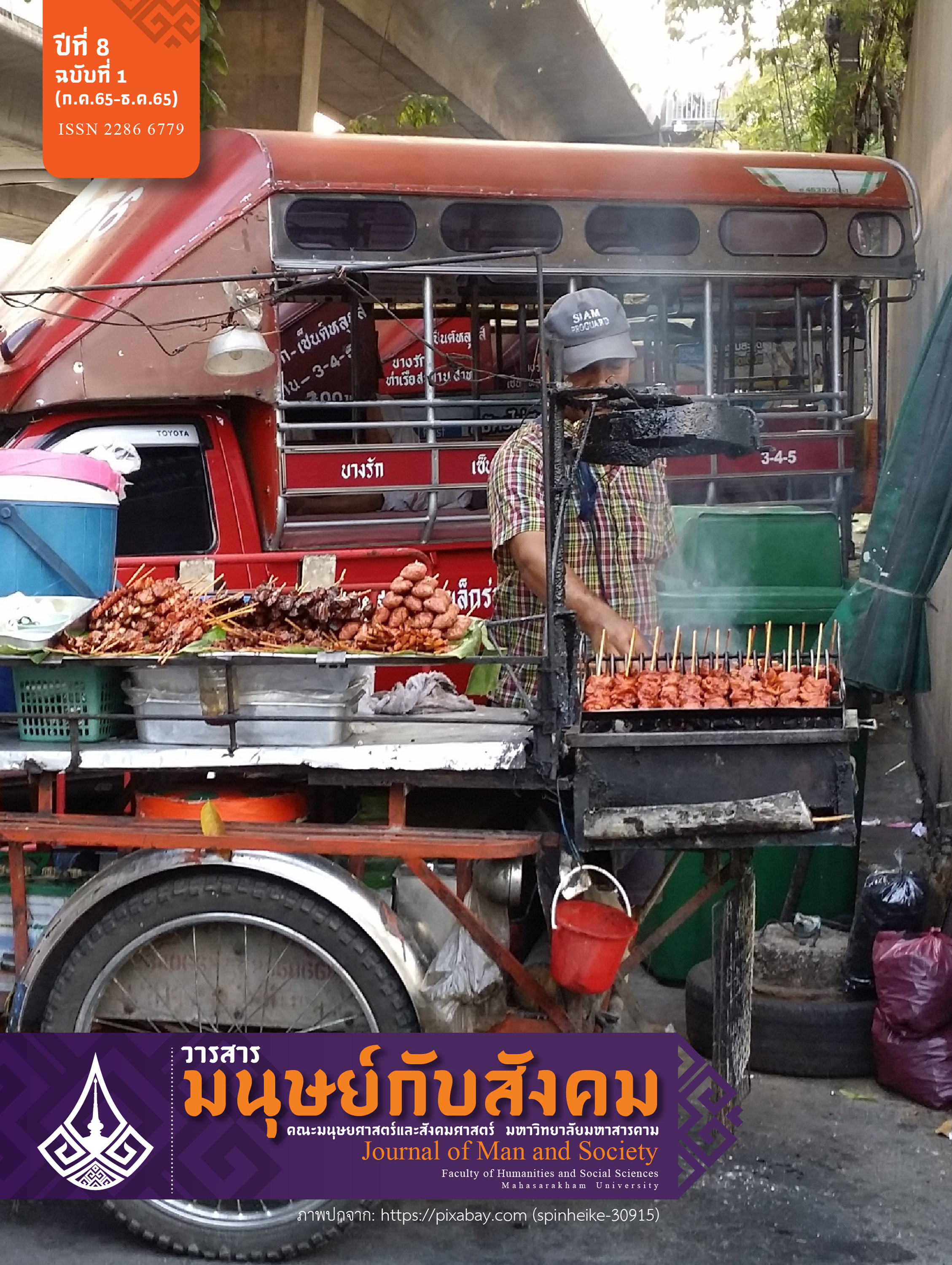การศึกษาผลของการใช้สื่อสังคมออนไลน์ที่มีความเสี่ยงต่อการมีภาวะซึมเศร้าและแนวโน้มจะฆ่าตัวตาย กรณีศึกษากลุ่มนักเรียนมัธยมศึกษาตอนปลาย โรงเรียนขนาดใหญ่พิเศษ ในเขตอำเภอเมืองมหาสารคาม
Main Article Content
บทคัดย่อ
บทความวิจัยนี้มีจุดประสงค์เพื่อศึกษาพฤติกรรมการใช้สื่อสังคมออนไลน์ การมีภาวะซึมเศร้า และการมีแนวโน้มจะฆ่าตัวตายและศึกษาสัมพันธภาพในครอบครัวว่ามีความสัมพันธ์กับตัวแปรเหล่านี้หรือไม่ รวมทั้งศึกษาเปรียบเทียบความเสี่ยงต่อการมีภาวะซึมเศร้าและแนวโน้มจะฆ่าตัวตายจากผลของการเสพติดสื่อสังคมออนไลน์ โดยขนาดตัวอย่างทั้งหมด 376 คน ใช้การเลือกตัวอย่างแบบแบ่งชั้นภูมิโดยการสุ่มแบบมีระบบ ผลการวิเคราะห์ข้อมูลพบว่า 1) นักเรียนส่วนใหญ่ใช้เวลาในการใช้สื่อสังคมออนไลน์ 6-9 ชั่วโมงต่อวัน มีการใช้งานสื่อสังคมออนไลน์ประเภท Facebook/Instagram และมีวัตถุประสงค์ในการใช้เพื่อความบันเทิงมากที่สุด เสพติดสื่อสังคมออนไลน์ ร้อยละ 83.78 มีภาวะซึมเศร้าร้อยละ 41.49 มีแนวโน้มจะฆ่าตัวตายระดับรุนแรงร้อยละ 3.72 2) สัมพันธภาพในครอบครัวมีความสัมพันธ์กับการเสพติดสื่อสังคมออนไลน์ ภาวะซึมเศร้า และแนวโน้มจะฆ่าตัวตาย 3) นักเรียนที่เสพติดสื่อสังคมออนไลน์มีความเสี่ยงที่จะมีภาวะซึมเศร้าสูงกว่านักเรียนที่ไม่เสพติดสื่อสังคมออนไลน์ และนักเรียนที่มีภาวะซึมเศร้ามีความเสี่ยงต่อการจะฆ่าตัวตายสูงกว่านักเรียนที่ไม่มีภาวะซึมเศร้า คนที่มีภาวะซึมเศร้าในกลุ่มที่เสพติดสื่อสังคมออนไลน์มีแนวโน้มจะฆ่าตัวตายสูงกว่าคนที่มีภาวะซึมเศร้าในกลุ่มที่ไม่เสพติดสื่อสังคมออนไลน์
Article Details

อนุญาตภายใต้เงื่อนไข Creative Commons Attribution-NonCommercial-NoDerivatives 4.0 International License.
เนื้อหาและข้อมูลที่ตีพิมพ์ลงในวารสารมนุษย์กับสังคม ถือเป็นข้อคิดเห็นและความรับผิดชอบโดยตรงของผู้เขียนซึ่งกองบรรณาธิการวารสารไม่จำเป็นต้องเห็นด้วยหรือร่วมรับผิดชอบใดๆ
บทความ ข้อมูล เนื้อหา รูปภาพ ฯลฯ ที่ได้รับการตีพิมพ์ในวารสารมนุษย์กับสังคม ถือเป็นลิขสิทธิ์ของวารสาร หากบุคคลหรือหน่วยงานใดต้องการนำทั้งหมดหรือส่วนหนึ่งส่วนใดไปเผยแพร่ต่อหรือเพื่่อกระทำการใดๆ จะต้องได้รับอนุญาตเป็นลายลักษณ์อักษรจากวารสารมนุษย์กับสังคมก่อน
เอกสารอ้างอิง
ครองรัตน์ ดุลลาพันธ์. (2561). พฤติกรรมการใช้เครือข่ายสังคมออนไลน์และปัจจัยทางจิต ที่พยากรณ์ภาวะโรคซึมเศร้า. วิทยานิพนธ์ศิลปศาสตรมหาบัณฑิต สาขาวิชานิเทศศาสตร์และนวัตกรรม สถาบันบัณฑิตพัฒนบริหารศาสตร์.
จุฑามาศ ทองประดับ ทัศนา ทวีคูณ และพัชรินทร์ นินทจันทร์. (2562). ความสัมพันธ์ระหว่างภาวะติดเฟซบุ๊กกับความรู้สึกมีคุณค่าในตนเองและภาวะซึมเศร้าในนักเรียนมัธยมศึกษาตอนปลาย. วารสารพยาบาลสภากาชาดไทย, 12(2), 116-133.
สำนักงานกองทุนสนับสนุนการสร้างเสริมสุขภาพ. (2563). Thaihealth Watch 2022 จับตาทิศทางสุขภาพคนไทยปี 2563 [ออนไลน์]. กรุงเทพฯ: สำนักงานกองทุนสนับสนุนการสร้างเสริมสุขภาพ. ได้จาก: https://bit.ly/3GjjFGL [สืบค้นเมื่อ 20 มกราคม 2524]
เฉลิมพล ก๋าใจ และอรัญญา นามวงศ์. (2562). ความสัมพันธ์ระหว่างการติดเฟซบุ๊ก ภาวะซึมเศร้าและความเสี่ยงต่อการฆ่าตัวตายของนักศึกษาพยาบาลยุคเจนเนอเรชันแซด. วารสารพยาบาลสาธารณสุข, 33(2), 33-47.
ตันติกร ชื่นเกษม. (2562). ความสัมพันธ์ของการเสพติดสื่อสังคมออนไลน์ที่มีต่อการใช้เวลากับครอบครัว ของนักเรียนระดับมัธยมศึกษาในเขตประเวศ กรุงเทพมหานคร. วิทยานิพนธ์รัฐศาสตรมหาบัณฑิต สาขาวิชายุทธศาสตร์และความมั่นคง มหาวิทยาลัยบูรพา.
ผู้จัดการออนไลน์. (2562). เมื่อสื่อโซเชียลเป็นต้นเหตุโรคซึมเศร้า. ได้จาก: https://mgronline.com/infographic/detail/9620000017907 [สืบค้นเมื่อ วันที่ 20 มกราคม 2564].
พัทธนันท์ เสนาจักร และลักขณา สริวัฒน์. (2563). การศึกษาความฉลาดทางดิจิทัลในระดับการใช้เทคโนโลยีดิจิทัลในเชิงสร้างสรรค์ ของนักเรียนโรงเรียนสารคามพิทยาคม อำเภอเมือง จังหวัดมหาสารคาม. วารสารการบริหารและนิเทศการศึกษา มหาวิทยาลัยมหาสารคาม, 11(1), 31-44.
สมิธ วุฒิสวัสดิ์. (2552). การศึกษาสัมพันธภาพในครอบครัวของนักเรียนช่วงชั้นที่ 2. สารนิพนธ์ปริญญาการศึกษามหาบัณฑิต สาขาวิชาจิตวิทยาการแนะแนว มหาวิทยาลัยศรีนครินทรวิโรฒ.
สุขภาพวัยรุ่นและเยาวชนไทย. (2563). โครงการสุขภาพคนไทย 2563. สถาบันวิจัยประชากรและสังคม มหาวิทยาลัยมหิดล.
สุพัตรา สุขาวห และสุวรรณา อรุณพงค์ไพศาล. (2560). ปัจจัยเสี่ยงและทฤษฎีที่เกี่ยวข้องกับการฆ่าตัวตายในวัยรุ่น: การทบทวนวรรณกรรมเชิงลึก. วารสารสมาคมจิตแพทย์แห่งประเทศไทย, 62(4), 359-378.
วิมลวรรณ ปัญญาว่อง และคณะ. (2563). ความชุกของภาวะซึมเศร้าและความเสี่ยงฆ่าตัวตายในวัยรุ่นไทย: การสำรวจโรงเรียนใน 13 เขตสุขภาพ. วารสารสุขภาพจิตแห่งประเทศไทย, 28(2), 136-149.
อังคณา ศิริอำพันกุล. (2561). ภาวะซึมเศร้ากับพฤติการณ์ใช้สื่อโซเชียล. วารสารปัญญาภิวัฒน์, 10(ฉบับพิเศษ), 327-337.
เอกชัย เพ็ชรพรประภาส. (2563). ความชุกและปัจจัยที่เกี่ยวข้องระหว่างการพยายามฆ่าตัวตายกับภาวะซึมเศร้าในโรงพยาบาลบางพลี จังหวัดสมุทรปราการ. วารสารสมาคมจิตแพทย์แห่งประเทศไทย, 65(2), 167-178.
Ade Ayu Harisdiane Putri and Hani Khairunnisa. (2018). The Relationship of Family Function and Social Media Addiction among Adolescents. Advances in Social Science, Education and Humanities Research (ASSEHR), volume 304, 4th ASEAN Conference on Psychology, Counselling, and Humanities.
Betul Keles and other. (2020). A systematic review: the influence of social media on depression, anxiety and psychological distress in adolescents. INTERNATIONAL JOURNAL OF ADOLESCENCE AND YOUTH, 25(1), 79–93.
Nitt Hanprathet and other. (2015). Facebook Addiction and Its Relationship with Mental Health among Thai High School Students. J Med Assoc Thai, 98(3), S81-S90.


